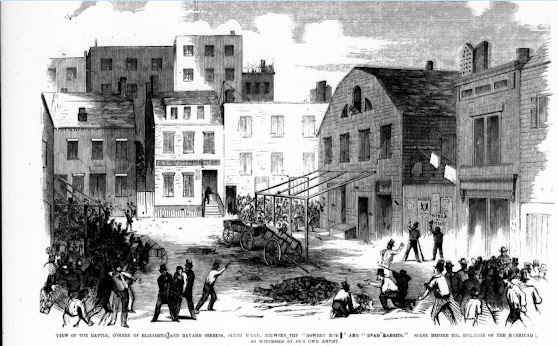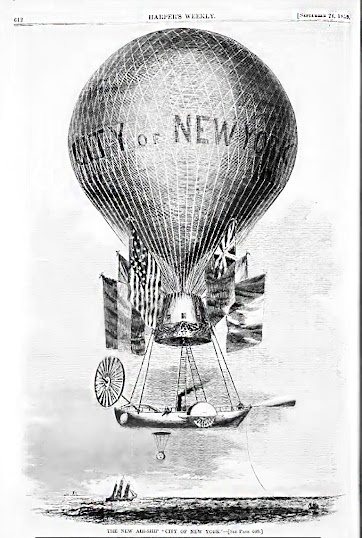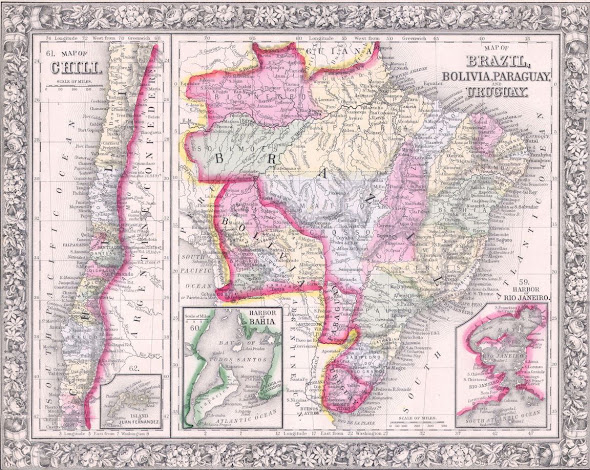The Dead Rabbit Riot--NYC July 1857
Dead Rabbits Riot
Frank Leslie’s Weekly
July 18, 1857
The riot which occurred in the Sixth Ward, on Saturday night,
July 4th between the Dead Rabbits and the Bowery Boys was the most
talked of fight among the many which have disgraced our city. One of our
artists happened at the height of the affair, to be passing in the vicinity, and
his attention was attracted by the distant sound of pistols firing and hurrahs
from the mob. Proceeding down Canal Street he soon found himself involved in
the conflict and after some difficulty picked out a tolerably safe place, from
which he could view the contest and make notes. As a result of his enterprise,
we have two pictures on this page, which are as literal as daguerreotypes. The
first picture shows the front on Elizabeth Street, looking down Bayard. The
corner was the key to the whole position, and around its angle was done all of
the hardest fighting. Here for three hours the Dead Rabbits and the Bowery Boys
kept up a skirmish which would have done honor to a stormed city, each party
for a moment victorious, and then resuming their respective positions. The
Bowery Boys endeavored to drive their opponents back towards Centre Street, the
Dead Rabbits to drive the Bowery Boys back to their headquarters. At no time
was there more than seventy five to a hundred men engaged, but towards the
close of the conflict the crowds of people and excited spectators in the cross
streets, particularly towards the Bowery, was immense, continually swaying to
and fro, and occasionally adding to the awful character of the moment by yells
and execrations.
There was a
pile of bricks on Elizabeth and another on Bayard, as will be seen in our
engraving; these bricks were broken into convenient sizes by boys and used with
effect as deadly as missiles. A good deal of strategic ability was displayed by
the Bowery Boys, when the Dead Rabbits came down Bayard Street towards
Mulberry, for there they were very effectually annoyed by brickbats, which were
thrown over the angle of the corner.
The combatants, fatigued with the use of ordinary missiles, finally introduced firearms, and shots were frequently exchanged on both sides. As the fight continued, the passions of those engaged became more and more excited, which was greatly increased by the bearing off from time to time of the wounded covered with blood, many often presenting the most ghastly spectacle.
The cry was
finally raised for the erection of barricades whereupon the Bowery Boys seized
a number of hose carriages and carts standing in Elizabeth Street, and the Dead
Rabbits grocers’ wagons, old barrels, and boxes at their command in Bayard
Street, and in a few minutes the work was accomplished; the Bowery Boys entrenched
in Bayard Street, near Elizabeth, the Dead Rabbits in the same Street less than
two hundred feet in front. Our second picture represents the view from the
barricade of the Dead Rabbits. The scene was now animated and exciting in the
extreme, and hostilities were carried on in the coolest and most scientific
manner. Brickbats, stones, broken jars, pistol shots, and occasionally a
fowling piece were discharged, the general din varied by showers of destructive
missiles from neighboring housetops. Occasionally, a Dead Rabbit, more brave
than his companions, would jump into the arena between the two barricades, and,
after performing deeds of desperate daring, would retreat back, amid the shouts
of encouragement by his compatriots. Not to be outdone, a Bowery Boy would next
jump into the enclosure, fire his weapon, and, if not disabled, would, amid the
approving cheers of his party, again mount the barricade. Infuriated women and
children occasionally joined in the battle. Meantime, as might be supposed,
many fell desperately wounded on both sides; in fact, the Bowery Boys force gradually
lessened by the absence of those who carried off the wounded, and meanwhile the
forces of Dead Rabbits, in spite of killed and wounded, appeared to increase.
Towards
nine o’clock the firing on both sides generally lessened; throughout the whole
engagement, if any Metropolitan policemen were present, they were not
recognizable, and the authorities did nothing to do with ending of the riot; it
died out because the parties engaged in it absolutely became fatigued and tired
of their work. A few police officers were present at the beginning of the affray
but soon ran off, some beaten and otherwise maltreated. The spectators, and they numbered by the
thousands, continually asked, “When will the military come?” “Why don’t the
authorities interfere?” But these questions were like calling on spirits of the
vasty deep, the rioters only stopped when they were physically exhausted, and
by mutual agreement suspended hostilities on both sides.
During the
riot, a young man acting with the Dead Rabbits, and evidently assisted by an old woman
and some ragged children, deliberately stepped behind some trees on Mulberry
Street, and, backwoods fashion, kept up a deliberate fire on the Bowery Boys.
The windows and house fronts in the vicinity were perforated with bullet holes,
and the streets were strewn with rubbish.
Among the incidents noticeable should
be mentioned a man who came out of a house on Bayard Street, armed with a
musket, which he raised to his shoulder and pointing it toward the Bowery Boys,
attempted to fire and instead of it going off, however, it only flashed in the
pan. He took it from his shoulder and was in the act of hitting his right hand
on the breech of the gun, probably in order to jar powder into the lock, when
one of the party behind the barricade of wagons seeing the maneuver took
deliberate aim and fired at him with his pistol. He jumped about three feet into
the air, gave one shriek, threw his musket some five feet over his head and
fell back on the sidewalk a corpse.
Officer Shangles,
in the dress of a private citizen, went down Bayard and announced himself a
deputy sheriff, and endeavored to quell the disturbance. While thus engaged, an
Irishman came toward him with a brickbat in his hand, and while threatening to
strike Shangles, was shot dead by some parties at a distance and fell at the
officer’s feet.
Death of a Dead Rabbit As He Fell At Officer Shangles Feet
These incidents seemed to act as
mesmeric checks on the part of the whole crowd of Rabbits, who desisted and
fell back, apparently satisfied with the contest for the time being. They then
proceeded to pick up their dead and wounded.
It was
believed that there were from twelve to eighteen of the Rabbits either killed
or mortally wounded, while on the part of the Bowery Boys, but one man had a wound
on the ankle from a pistol, and another shot through the fleshy part of the
hands. In this conflict nine persons are known to authorities as dead and near
fifty wounded.
At about
seven o’clock on Sunday evening, July 5th, it would appear, that heroes
of the barricades and kindred spirits got into a difficulty at the Five Points,
taking umbrage at a storekeeper who refused to give liquor to his “customers”
without remuneration. For this most objectionable conduct his windows and
furniture were smashed, and himself and his friends most severely beaten.
The inmates
of the store, however, rallied together and determined to defend their castle
to the last extremity. They collected a quantity of old bottles and other
missiles and made stout resistance to the assailants, and succeeded after a deal
of hard fighting in driving them up Worth as far as Central Street.
....The latter retreated in good order until they got as far as Mission Place, when they again gave battle to the rowdies and fired bricks and stones with pretty tolerable effect.
This sort of skirmishing continued for nearly half an hour, when the Five Points people began to arm themselves with guns and pistols, finding they could not get rid of their assailants without resorting to powder and ball, they let fly a volley of pistol bullets at the enemy, doing considerable damage. The fire was returned from the other side, and matters were assuming an alarming color when Mr. Pease, of the Five Points Mission House, rushed into the midst of the combatants and succeeded in effecting a truce between the contending forces. Peace was soon afterwards restored, and all proper attention paid to the wounded. Those who had been most active in the riot were most delinquent in their efforts to attend to the wants of those injured in the fray.
After peace had been fully restored the military (the Seventh and Seventy-first regiments) appeared upon the battlefield and struck terror to the hearts of people residing in the neighborhood. After patrolling the district for some time the order was given to march to the arsenal.
CAPTURE OF THE HOWITZER
At half past eight on Saturday evening, Deputy Carpenter, with a large force of Metropolitans, left 88 White Street, with the design of proceeding to the scene of the riot and clearing the streets. They proceeded down White Street to Elm, through Elm to Franklin to Centre street, where, as had been previously agreed, they were met by the military above named, who feel in their rear as a body guard. The entire force then marched through Centre and Anthony streets to Five Points, where they stopped for five or ten minutes to quiet the populace, clear the streets and shut up all houses. They then proceeded on their route, clearing a passage all the way up Anthony, Mulberry and Bayard streets to the Bowery.
Near the corner of Mulberry and Bayard Streets, a number of stones were thrown from a building which had in the previous affrays become conspicuous for the belligerent character of its inmates. Accordingly General Sandford, General Hall and a number of police entered the house and made several arrests. The force then proceeded up Bayard street towards the Bowery, and on turning the corner came suddenly upon the Bowery Boys, having a six-pound carronade or howitzer, said to have been loaded with grapeshot. This was soon taken possession of, and the line of march was continued through the Bowery, Canal, Mulberry, Baxter and White Streets, home clearing the streets all the way and closing the houses.
This spiteful-looking piece of ordinance was mounted on a large lumber wagon, and had it been fired, it would most likely have gone clean through the bottom of the vehicle, on its first discharge.










You're a real history buff, Joel. I enjoyed reading this piece. bob
ReplyDelete